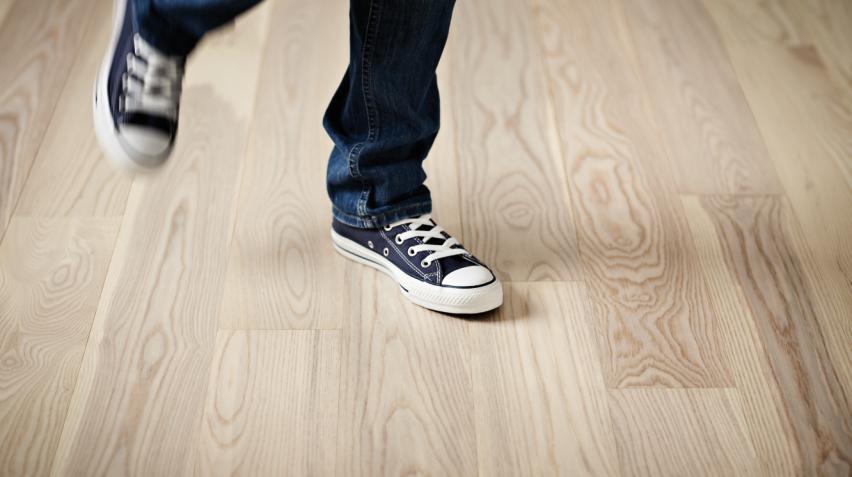GUIDANCE
Frequently Asked Questions About Wood Floors
How to install a hardwood floor? add
Installing a hardwood floor starts with careful preparation and choosing the right method for your project.
Preparation & Tools
Before laying your floor, ensure the subfloor is clean, dry, and level. You’ll also need the right set of tools — from saws and spacers to adhesives and nailers — as outlined in our Hardwood Flooring Tools checklist . Good preparation makes the installation process smoother and helps avoid costly mistakes later.
Installation Methods
There are several ways to install hardwood floors. For many projects, a glue down method or gluing to concrete provides a solid, permanent foundation. For beginners, our step-by-step guide covers the basics of laying both solid and engineered floors.
Parquet & Special Patterns
If you are looking for a decorative option, parquet flooring offers unique patterns such as herringbone or basket weave. Learn more in our guide on parquet flooring installation .
Underlayment & Moisture Protection
Depending on your project, underlayment and moisture barriers may be required. A moisture barrier protects the wood against damp conditions, while underlayment improves comfort, sound absorption, and stability. If you are using a glue-down system, see our full guide: Do you need underlayment for glue down hardwood floors?
Aftercare
Once installed, follow the installation and aftercare guide to ensure your floor remains beautiful and durable for years to come.
Whether you’re gluing, nailing, or laying parquet, these resources cover everything from prep to finish, ensuring your hardwood floor is installed correctly and ready for decades of use.
How do I clean and maintain my hardwood floor? add
Keeping your hardwood floors beautiful and durable comes down to a simple, consistent routine, and choice of the right products. Start with daily or weekly care: sweep or vacuum to remove dust and grit, then use a damp (never wet) mop with a pH-neutral cleaner designed for wood. Avoid harsh products such as bleach, vinegar, or steam. For full guidance, see our resources on How to Maintain a Wood Floor for Lasting Beauty or visit our expert guide.
If you want to disinfect, choose a wood-safe product, apply it with a well-wrung microfiber mop, and dry the surface immediately. Detailed step-by-step instructions can be found in How to Disinfect Wood Floors.
If your hardwood floor has special finishes, they may need tailored care. For oil-finished hardwood, it is advantageous to use oil-compatible cleaners and refreshing the surface periodically with maintenance oil and products that ensure your floor is protected in the long run.
By following these best practices, you’ll protect the finish, preserve the natural beauty of your Junckers hardwood, and enjoy floors that last for generations.
Should I remove my hardwood flooring? add
If your hardwood floor is severely worn, has already been sanded several times, or no longer performs as it should, replacement may be the right choice. You can learn more about the process in our guide on removing hardwood floors.
That said, a complete replacement is rarely necessary if your floor simply looks dull or tired. In such cases, we usually recommend refinishing rather than painting. Paint sits as a layer on top of the wood, making it prone to scratches, chips, and visible wear—especially in high-traffic areas. Still, if a painted floor fits your style and aesthetic, it can be an option. To make the right choice and avoid common pitfalls, see our guide on how to avoid the most common mistakes when painting your floor.
If only a small section is damaged, there’s no need to replace the entire floor. Individual boards can often be repaired or replaced. In most cases, refinishing —sanding and resealing the surface—can restore both the beauty and performance of your floor. See our complete guide on when and how to refinish your wood floors.
If you’re uncertain about the best solution, don’t hesitate to contact Junckers Technical Service for expert guidance tailored to your floor and situation.
What is a moisture barrier? add
A moisture barrier is a protective layer placed between your hardwood floor and the subfloor to stop water vapor from seeping upward and damaging the wood. Because solid hardwood is a natural material, it will expand, contract, or even warp if exposed to excess moisture over time. A moisture barrier prevents these issues by keeping your floor stable, beautiful, and long-lasting.
How do I fix stained floors? add
If your hardwood floor becomes stained, it’s important to act quickly and choose the right cleaning method for the type of spill. This is especially relevant in kitchens, where everyday cooking and food preparation often lead to splashes, grease, or oil marks.
Oil stains can be particularly challenging because the liquid penetrates the natural pores of the wood. The first step is to gently blot the spill with a clean, dry cloth—never rub, as this can push the oil deeper into the grain. Next, apply baking soda or cornstarch directly onto the affected area to draw out the oil. After letting it sit, carefully sweep or vacuum it away, and then spot-clean with a wood-safe solution. For a more detailed description, you can visit our guide on removing oil stains from wood floors.
If the issue isn’t oil but paint stains, the process is different. Paint requires a careful approach to avoid damaging the protective finish or the wood itself. You’ll find clear instructions on safe removal techniques, products to use, and mistakes to avoid in our dedicated guide on How to Remove Paint from a Wood Floor.






